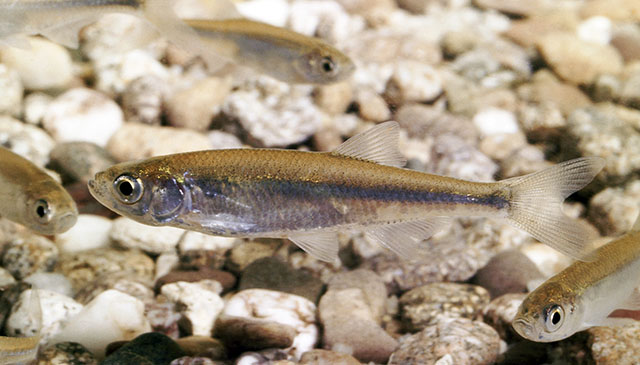| Leuciscidae (Minnows), subfamily: Leuciscinae |
| 9 cm SL (male/unsexed); max. reported age: 2 years |
|
pelagic; freshwater; brackish; pH range: 6 - 10; dH range: 15; depth range 0 - 1 m, potamodromous |
| Europe and Asia: From Lower Rhine and northern Germany eastward to southern Baltic basin; Black Se basin south to Rioni drainage, northern and western Caspian basin (south to Kura drainage); Aegean Sea basin (from Maritsa to Nestos). Absent in Italy, Adriatic basin, Great Britain and Scandinavia (except southernmost Sweden). Widely introduced in France, upper Rhine drainage and locally in Great Britain and Swiitzerland. |
|
Dorsal spines (total): 2-3; Dorsal soft rays (total): 7-9; Anal spines: 3-3; Anal soft rays: 10-13; Vertebrae: 36-42. Diagnosed from other cyprinids in central and eastern Europe by having incomplete lateral line with about 8-12 pored scales, keel covered by scales between pelvic origin and anus, mouth superior, and 11-13½ branched anal rays (Ref. 59043). A small fish with large silvery scales and an inconspicuous intense silvery band along each side. Lateral line incomplete, sometimes absent, with perforated scales. Anal fin longer than dorsal fin. Mouth turns upwards. The lower edge of the body between the pelvic fins and the vent forms a sharp keel. The scales are very loosely attached and fall away if the fish is handled. Also Ref. 40476. |
| Inhabits lowland riverine habitats especially oxbows and other water bodies only connected to rivers during floods. Often encountered in ponds, steppe lakes and small water bodies not connected to rivers (Ref. 59043). Occurs in large schools which are most numerous in autumn. Found between weeds in shallow pools and creeks, shallow lakes, peat and clay excavations and canals. It is exposed to the stormy flow of water (in spring, autumn and winter), but usually choose quite places like small bays, plots behind bottom stones extending out of water and concrete foundations of bridges. In autumn, the schools of fish keep to the surface and rarely go to the pelagic zone. Towards winter, the schools break up and the number of fish per unit of river square decreases rapidly (Ref. 27674); they spend the winter in deeper waters (Ref. 41592). Feeds on phytoplankton and zooplankton and on flying insects (Ref. 27368). Spawns among vegetation (Ref. 30578). Aquarium keeping: at least 10 individuals; minimum aquarium size 100 cm; not recommended for home aquariums (Ref. 51539). Scales were utilized for production of Essence d'Orient, which was used for coating artificial pearls. Locally threatened due to draining of wetlands. Reaches up to about 9 cm SL (Ref. 59043). |
|
Least Concern (LC); Date assessed: 01 January 2008 Ref. (130435)
|
| harmless |
Source and more info: www.fishbase.org. For personal, classroom, and other internal use only. Not for publication.

